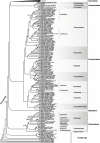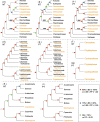A plastid phylogenomic framework for the palm family (Arecaceae) - PubMed
- ️Sun Jan 01 2023
A plastid phylogenomic framework for the palm family (Arecaceae)
Gang Yao et al. BMC Biol. 2023.
Abstract
Background: Over the past decade, phylogenomics has greatly advanced our knowledge of angiosperm evolution. However, phylogenomic studies of large angiosperm families with complete species or genus-level sampling are still lacking. The palms, Arecaceae, are a large family with ca. 181 genera and 2600 species and are important components of tropical rainforests bearing great cultural and economic significance. Taxonomy and phylogeny of the family have been extensively investigated by a series of molecular phylogenetic studies in the last two decades. Nevertheless, some phylogenetic relationships within the family are not yet well-resolved, especially at the tribal and generic levels, with consequent impacts for downstream research.
Results: Plastomes of 182 palm species representing 111 genera were newly sequenced. Combining these with previously published plastid DNA data, we were able to sample 98% of palm genera and conduct a plastid phylogenomic investigation of the family. Maximum likelihood analyses yielded a robustly supported phylogenetic hypothesis. Phylogenetic relationships among all five palm subfamilies and 28 tribes were well-resolved, and most inter-generic phylogenetic relationships were also resolved with strong support.
Conclusions: The inclusion of nearly complete generic-level sampling coupled with nearly complete plastid genomes strengthened our understanding of plastid-based relationships of the palms. This comprehensive plastid genome dataset complements a growing body of nuclear genomic data. Together, these datasets form a novel phylogenomic baseline for the palms and an increasingly robust framework for future comparative biological studies of this exceptionally important plant family.
Keywords: Arecaceae; Nuclear-plastid discordance; Palmae; Phylogenomics; Plastome.
© 2023. The Author(s).
Conflict of interest statement
The authors declare that they have no competing interests.
Figures

Maximum likelihood (ML) phylogenetic tree of Arecaceae inferred from the incomplete-105 regions matrix. Bootstrap support (BS) values inferior to 100% are shown, with dashes denoting a support inferior to 50%. Numbers in brackets indicate the BS values obtained from the analyses of the complete-coding/complete-105 matrices. Taxon names are followed by their GenBank accession numbers (sequences downloaded from NCBI) or voucher specimen information (plastomes newly obtained). For the 49 genera with a large proportion of missing data and for which individual plastid regions had to be retrieved from NCBI (see the “Methods” section), only the genus name is provided, but detailed sequence accession numbers can be found in Additional file 2: Table S2

Maximum likelihood (ML) phylogenetic tree of Arecaceae inferred from the incomplete-105 regions matrix. Bootstrap support (BS) values inferior to 100% are shown, with dashes denoting a support inferior to 50%. Numbers in brackets indicate the BS values obtained from the analyses of the complete-coding/complete-105 matrices. Taxon names are followed by their GenBank accession numbers (sequences downloaded from NCBI) or voucher specimen information (plastomes newly obtained). For the 49 genera with a large proportion of missing data and for which individual plastid regions had to be retrieved from NCBI (see the “Methods” section), only the genus name is provided, but detailed sequence accession numbers can be found in Additional file 2: Table S2

Comparison between the palm topologies derived from nuclear and plastome data. a‒c Tribal relationships in Arecoideae, the arrowhead indicates the crown of the core arecoids; d, e tribal and subtribal relationships in Calamoideae; f, g tribal relationships in Ceroxyloideae; h, i subtribal relationships in Trachycarpeae (Coryphoideae); NT nuclear topology, PT plastome topology; NT were obtained a from the maximum likelihood analysis of Comer et al. [39]; b, h from the multispecies coalescent analysis of KTLE [60] (KTLE tree); d from the multispecies coalescent analysis of Kuhnhäuser et al. [49]; and f from the maximum parsimony analysis of Baker et al. [66]; PT of c, e, g, and i were all obtained from the present study
Similar articles
-
de Santana Lopes A, Gomes Pacheco T, Nimz T, do Nascimento Vieira L, Guerra MP, Nodari RO, de Souza EM, de Oliveira Pedrosa F, Rogalski M. de Santana Lopes A, et al. Planta. 2018 Apr;247(4):1011-1030. doi: 10.1007/s00425-018-2841-x. Epub 2018 Jan 16. Planta. 2018. PMID: 29340796
-
Barrett CF, Baker WJ, Comer JR, Conran JG, Lahmeyer SC, Leebens-Mack JH, Li J, Lim GS, Mayfield-Jones DR, Perez L, Medina J, Pires JC, Santos C, Wm Stevenson D, Zomlefer WB, Davis JI. Barrett CF, et al. New Phytol. 2016 Jan;209(2):855-70. doi: 10.1111/nph.13617. Epub 2015 Sep 9. New Phytol. 2016. PMID: 26350789
-
A robust phylogenomic framework for the calamoid palms.
Kuhnhäuser BG, Bellot S, Couvreur TLP, Dransfield J, Henderson A, Schley R, Chomicki G, Eiserhardt WL, Hiscock SJ, Baker WJ. Kuhnhäuser BG, et al. Mol Phylogenet Evol. 2021 Apr;157:107067. doi: 10.1016/j.ympev.2020.107067. Epub 2021 Jan 5. Mol Phylogenet Evol. 2021. PMID: 33412273
-
The plastome sequence of Bactris gasipaes and evolutionary analysis in tribe Cocoseae (Arecaceae).
Santos da Silva R, Roland Clement C, Balsanelli E, de Baura VA, Maltempi de Souza E, Pacheco de Freitas Fraga H, do Nascimento Vieira L. Santos da Silva R, et al. PLoS One. 2021 Aug 24;16(8):e0256373. doi: 10.1371/journal.pone.0256373. eCollection 2021. PLoS One. 2021. PMID: 34428237 Free PMC article.
-
Nuclear phylogenomics of angiosperms and insights into their relationships and evolution.
Zhang G, Ma H. Zhang G, et al. J Integr Plant Biol. 2024 Mar;66(3):546-578. doi: 10.1111/jipb.13609. Epub 2024 Jan 30. J Integr Plant Biol. 2024. PMID: 38289011 Review.
Cited by
-
Xue B, Huang E, Zhao G, Wei R, Song Z, Zhang X, Yao G. Xue B, et al. Ann Bot. 2024 May 10;133(5-6):697-710. doi: 10.1093/aob/mcae003. Ann Bot. 2024. PMID: 38230804 Free PMC article.
-
Introducing palmfungi.org, an integrated fungal-host data platform.
Xiong Y, Ishara MS, Hyde KD, Taylor JE, Phillips A, Pereira DS, Lu L, Zhang SN, Mapook A, Xu B. Xiong Y, et al. Biodivers Data J. 2024 Oct 2;12:e126553. doi: 10.3897/BDJ.12.e126553. eCollection 2024. Biodivers Data J. 2024. PMID: 39391555 Free PMC article.
-
Characterization, comparison, and phylogenetic analyses of chloroplast genomes of Euphorbia species.
Lee SR, Oh A, Son DC. Lee SR, et al. Sci Rep. 2024 Jul 4;14(1):15352. doi: 10.1038/s41598-024-66102-0. Sci Rep. 2024. PMID: 38961172 Free PMC article.
-
Phylogenomics analysis of Scutellaria (Lamiaceae) of the world.
Wang Y, Xu C, Guo X, Wang Y, Chen Y, Shen J, He C, Yu Y, Wang Q. Wang Y, et al. BMC Biol. 2024 Sep 2;22(1):185. doi: 10.1186/s12915-024-01982-2. BMC Biol. 2024. PMID: 39218872 Free PMC article.
-
Chloroplast genome of Calamus tetradactylus revealed rattan phylogeny.
Zhang H, Liu P, Zhang Y, Sun H, Wang Y, Gao Z, Liu X. Zhang H, et al. BMC Genom Data. 2024 Mar 25;25(1):34. doi: 10.1186/s12863-024-01222-0. BMC Genom Data. 2024. PMID: 38528505 Free PMC article.
References
-
- Zhang C, Zhang T, Luebert F, Xiang Y, Huang C-H, Hu Y, et al. Asterid phylogenomics/phylotranscriptomics uncover morphological evolutionary histories and support phylogenetic placement for numerous whole-genome duplications. Mol Biol Evol. 2020;37(11):3188–3210. doi: 10.1093/molbev/msaa160. - DOI - PubMed
Publication types
MeSH terms
LinkOut - more resources
Full Text Sources
Miscellaneous